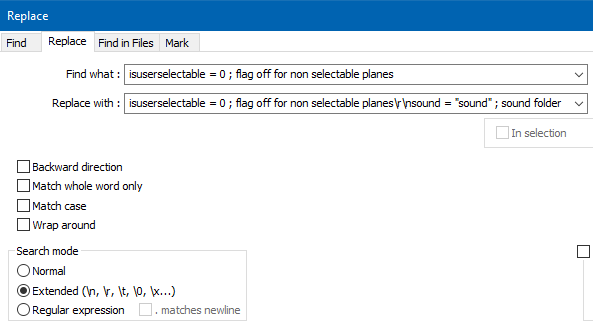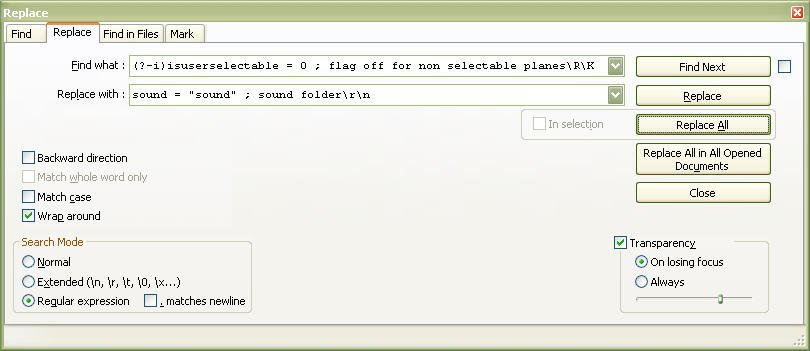Paste every "say 37th line" apx..
-
ok so search for isuserselectable = 0 ; flag off for non selectable planes…so far so good lol
-
not sure about what of this goes in the search line?
After searching for the line isuserselectable = 0 ; flag off for non selectable planes, respecting the case (?-i) and its line-ending characters \R, the \K feature resets the search and simply matches the zero-length location, right after this line -
not sure about what of this goes in the search line?
After searching for the line isuserselectable = 0 ; flag off for non selectable planes, respecting the case (?-i) and its line-ending characters \R, the \K feature resets the search and simply matches the zero-length location, right after this lineonce i get the hang of this…then i have maybe 100 more airplanes …lol
-
So, when @guy038 said:
SEARCH (?-i)isuserselectable = 0 ; flag off for non selectable planes\R\K
REPLACE sound = “sound” ; sound folder\r\n ( OR sound = “sound” ; sound folder\n if UNIX files )
He meant for “SEARCH” that you would put this in the box labeled Find what:
And correspondingly, “REPLACE” means look for the Replace with box.
Does that help?
-
yeah…I think I lost my “isuserselectable = 0 ; flag off for non selectable planes” because it replaced it with the sound stuff…lol but it added sound i think 736 times…so rather than replace that line…insert the sound line below it…this was on a trial cfg not the real one yet till i get this down.
-
But, because you’re an admitted noob, why not do a simpler-to-understand Extended mode replacement, like this:

Notice:
-
the Search mode has been set to Extended – this allows you to do fancy things (over and above what a Normal search allows) like specify multiple lines in your data (here you are replacing one-line with two (the original plus a new one).
-
the
\r\nin the Replace with data is what creates a second line in your data; it is the “dividing point” between two lines
Is this easier to see/understand?
-
-
-
-
@guy038
t seems now its just stopped replacing…say no occurences were replaced …etcThank you,
Bob M. -
If I need to change this: isuserselectable = 0 ; flag off for non selectable planes to this:
isUserSelectable = 0 ; (on the end of search line after 0 ; \R\K
and still replace with:
sound = “sound” ; sound folder (sound = “sound” ; sound folder\r\n)
-
Your last post isn’t quite clear but I guess you would like to add the line
sound = "sound" ; sound folderright after each line beginning withisuserselectable = 0, whatever the contents of a possible comment area, coming next the colon characterIf so, change the search regex, only, as :
SEARCH
(?-si)isuserselectable = 0.*\R\K-
The
(?-s)part means that anydotmeta-character matches a single standard character -
The
.*syntax, before the\R, represents the area, possibly empty, of standard character(s), after the string= 0and before the EOL chars
I advice you to get documentation on the regex world, in this FAQ
Best regards,
guy038
-
-
Hey Thank you…You are awesome…thanks for all your help!! Defeinitely check out the faq…
BobM.
-
Just curious and maybe it can’t be done… but lets say I have 100 Fltsims and I want to be apostrophe’s at the beginning and end of the title line only…can that be done…here’s a sample:
[fltsim.1]
title=“JFAI_737_300_AirChina”
sim=TrafficGlobal
model=
panel=x
sound=
texture=AirChina
atc_id=B737
atc_flight_number=
atc_airline=AIR CHINA
atc_parking_codes=CCA
atc_parking_types=GATE,RAMP
ui_manufacturer=Boeing
ui_type=B733
ui_variation=Air China
description=AI
ui_typerole=Traffic Global AI
ui_createdby=Just Flight[fltsim.2]
title=“JFAI_737_300_AllNippon”
sim=TrafficGlobal
model=
panel=x
sound=
texture=AllNippon
atc_id=B737
atc_flight_number=
atc_airline=ALL NIPPON
atc_parking_codes=ANA
atc_parking_types=GATE,RAMP
ui_manufacturer=Boeing
ui_type=B733
ui_variation=All Nippon
description=AI
ui_typerole=Traffic Global AI
ui_createdby=Just FlightSo in other words…I would open the document in Notepad++ and want to put the apostrophe at the beginning and end of just the “Title line” for each fltsim section…1,2,3, etc… Might have to do a couple thousand of these…lol
i learned so much yesterday on the little I did that now I am dangerous!!!
BobM.
-
@Carolina-Number-1 said in Paste every "say 37th line" apx..:
So, presuming you have:
title=JFAI_737_300_AirChinaand you want that to be changed into:
title="JFAI_737_300_AirChina"and that is the only thing you have on the line…
Then you could do:
find:
(?-s)^title=(.+)
repl:title="${1}"
mode: Regular expressionThere are of course some other ways, but this is probably the simplest, and I don’t think it is really worth showing a total noob some of the other ways at this point, because the confusion factor would just skyrocket.
-
Hey Thanks!! Never been called a a total noob before… I am so honored…lol
Warmest Greets…Stay Safe!!
BobM.
-
@Alan-Kilborn worked like a charm…zowie :)
BobM.
-
Hi, @carolina-number-1 and All,
I guess that you want to surround any text after the string
title =with two double-quotes"If so, this regex S/R is the right one :
SEARCH
(?-si)^(title\x20*=\x20*+)(?!")(.+)REPLACE
\1"\2"As usual :
-
Tick the
Wrap aroundoption and select theRegular expressionsearch mode -
Click, either, several times on the
Replacebutton or once only on theReplace Allbutton
Notes :
-
The part
(?-si)^(title\x20*=\x20*)selects the stringtitle, with that exact case ((?-i)), at beginning of line (^), followed with the equal sign (=), possibly preceded and/or followed with space char(s) (\x20*) and stores all in group1 -
Remark that the
\x20*+regex range of space chars, after the equal sign, defines an atomic structure. This means that no backtracking will be done, by the regex engine, in that range of spaces. In other words, this means : "search for possible space chars, after the=sign, and verify, immediately that the next char is not a double-quote sign" -
As said above, the part
(?!")is a negative look-ahead structure. which tests, if, at current position, a"symbol can be found. If not, the condition is considered as TRUE and the current match attempt is OK, so far -
Then, the part
(.+)matches the remaining standard characters of current line and stores them as group2 -
The replacement part
\1"\2"rewrites these two groups, with two doubles quotes surrounding the group2
Remark that the
(?!")regex part avoids to surround an area, already surrounded with double-quotes, which would give, for instance, ““some text””, in case you would click twice on theReplace Allbutton@carolina-number-1, do not bother about
atomicquantifiers andlook-aroundstructures, for the moment !, You have plenty of basic regex expressions to learn before ;-))Best Regards,
guy038
-
-
@guy038 Thank you!!
BobM.
-
@Alan-Kilborn said in Paste every "say 37th line" apx..:
I don’t think it is really worth showing a total noob some of the other ways at this point, because the confusion factor would just skyrocket.
It appears that I was disagreed with on the above point.
-
Hi, All,
I’m going to explain the benefit of the
atomicquantifiers, by adding the+symbol after the greedy quantifier !Let’s consider these four lines text below, with
2without leading space chars and2with four leading space chars :abc "abc" abc "abc"And let’s suppose that we want to surround the string
abcwith double quotes, only in line1and3You could say that the following search regex
SEARCH
^(\x20*)(?!")(.+)Would match the line
1and3, only. However, it also matches the fourth line ! Why ?
Well, a very important thing to remember, about regex engines, is that, regex engines try, by all means, to get an overall match. In other words, they, desperately, try to find a solution, by testing all the possible combinations, provided by the search regex !
So, let’s imagine the regex engine at beginning of the line
4of our sample :-
Once the regex engine has consumed all the possible space chars (
^(\x20*)), it tests if the next char is not a"character. As it’s false, this means that the negative look-ahead return FALSE and no match can occur -
The regex engine don’t give up and backtracks, considering all space chars, but the last, as matching the
^(\x20*)regex, too -
Thus, the next char is the last space character, which does match the last
.+regex part and is not a double quote ! So, the(?!")part return TRUE and the overall regex can match the fourth line. -
But we do not want this match as, after replacement, we would get
"" ......."". So, in our regex, the solution is to use theatomicquantifier*+, instead of the greedy quantifier*. Indeed, when the regex engine meets an atomic quantifier, it will never backtrack inside the quantified area !
SEARCH
^(\x20*+)(?!")(.+)- Thus, after matching all the space chars, it just tests if the next char is not a
"character. As it’s false, this means that the negative look-ahead is FALSE. But, as the backtracking feature is forbidden, the regex engine stops and returns no match , for the fourth line contents
As a summary, by preventing the regex engine from backtracking, the
atomicquantifiers may reduce, drastically, the number of combinations, tested by the regex engine, and/or avoid testing some alternatives, particularly in recursive regexes.That leads to safer and quicker regexes’s execution !BR
guy038
-
